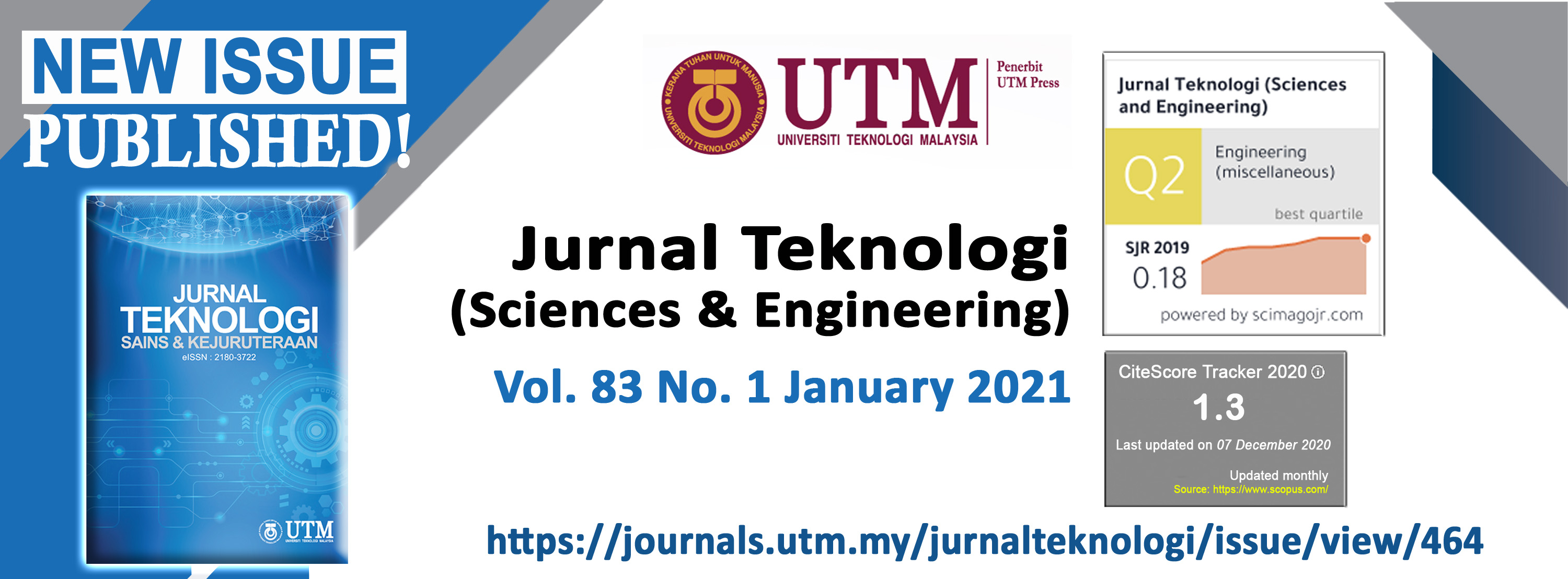CONTINUITY OF GREAT SUMATRAN FAULT IN THE MARINE AREA REVEALED BY 3D INVERSION OF GRAVITY DATA
DOI:
https://doi.org/10.11113/jurnalteknologi.v83.14824Keywords:
Great Sumatran Fault, Andaman Fault, Gravity Satellite, Derivative, 3D Gravity Inversion, disaster mitigationAbstract
The Great Sumatran Fault (GSF) is a 1900-km-long fault extending from Lampung, Indonesia, to India's Andaman Islands. The fault location is not only on the land but also in the marine area. Previous studies were only focused on the land area of Sumatra and Andaman Islands even though the marine fault has also impacted earthquakes and tsunamis such as in 2004. As an effort to disaster risk mitigation, this study used the gravity method to map and study the continuity of the GSF in the marine area from the Aceh Province, Indonesia, to the Andaman Islands, India. The gravity data were obtained from Topex with a resolution of 1.85 km/px. Based on the Bouguer data, the subduction zone in the western part of the Indian Ocean is observed with the anomaly of 500–700 mGal, while the residual structure of GSF, relative to the subduction zone, only comes to clarity through a horizontal derivative transformation with anomaly 130-250 mGal. To delineate the fault's geometry, the data were inverted by GRABLOX 1.6 using Singular Value Decomposition and Occam methods. The 3D modeling results also clearly show the contrast density between regional faults such as subduction zones on the Westside of the West Andaman Fault (WAF). The GSF faults can also be well demonstrated at 50 km depth. Based on these results, the gravity Topex is potentially used as a preliminary study of the GSF activity in the marine area.
References
Natawidjaja, D. H, and Sieh, K. 1994. Slip-rate along the Sumatran transcurrent fault and its tectonic significance, paper presented at conference on Tectonic Evolution of Southeast Asia. Geol. Soc. London.
Muksin, U., Rusydy, I., Erbas, K., and Ismail, N. 2018. Investigation of Aceh segment and Seulimeum fault by using seismological data; a preliminary result. In Journal of Physics: Conference Series. 1011(1): 012031. DOI:https://doi.org/10.1088/1742-6596/1011/1/012031
Marwan, A., Yanis, M., and Furumoto, Y. 2019. Lithological identification of devastated area by Pidie Jaya earthquake through Poisson’s ratio analysis. International Journal of Geomate. 17(63): 17 - 63. DOI: https://doi.org/10.21660/2019.63.77489
Ito, T., Gunawan, E., Kimata, F., Tabei, T., Simons, M., Meilano, I., Agustan., Otha, Y., Nurdin, I., Sugiyanto, D. 2012. Isolating alongâ€strike variations in the depth extent of shallow creep and fault locking on the northern Great Sumatran Fault. Journal of Geophysical Research: Solid Earth. 117(B6). DOI: https://doi.org/10.1029/2011JB008940
Weller, O., Lange, D., Tilmann, F., Natawidjaja, D., Rietbrock, A., Collings, R, and Gregory, L. 2012. The structure of the Sumatran Fault revealed by local seismicity. Geophysical Research Letters. 39(1). DOI: https://doi.org/10.1029/2011GL050440
Ghosal, D., Singh, S. C., Chauhan, A. P. S., and Hananto, N. D. 2012. New insights on the offshore extension of the Great Sumatran fault, NW Sumatra, from marine geophysical studies. Geochemistry, Geophysics, Geosystems. 13(11). DOI: https://doi.org/10.1029/2012GC004122
Janin, A., Rodriguez, M., Sakellariou, D., Lykousis, V., and Gorini, C. 2019. Tsunamigenic potential of a Holocene submarine landslide along the North Anatolian Fault (northern Aegean Sea, off Thasos Island): insights from numerical modelling. Natural Hazards & Earth System Sciences. 19(1): 121 - 136. DOI: https://doi.org/10.5194/nhess-19-121-2019
Wada, S., Sawada, A., Hiramatsu, Y., Matsumoto, N., Okada, S., Tanaka, T., and Honda, R. 2017. Continuity of subsurface fault structure revealed by gravity anomaly: the eastern boundary fault zone of the Niigata plain, central Japan. Earth, Planets and Space. 69(1): 1-12. DOI: https://doi.org/10.1186/s40623-017-0602-x
Lenhart, A., Jackson, C. A. L., Bell, R. E., Duffy, O. B., Gawthorpe, R. L., and Fossen, H. 2019. Structural architecture and composition of crystalline basement offshore west Norway. Lithosphere. 11(2): 273-293. DOI: https://doi.org/10.1130/L668.1
Kamesh Raju, K. A., Murty, G. P. S., Amarnath, D., and Kumar, M. M. 2007. The west Andaman fault and its influence on the aftershock pattern of the recent megathrust earthquakes in the Andamanâ€Sumatra region. Geophysical Research Letters. 34(3). DOI: https://doi.org/10.1029/2006GL028730
Kaye, S. J., and Milsom, J. S. 1988. Report on the gravity and magnetic survey of the Tanimbarand Kai Islands, Eastern Indonesia University College London, Gravity Research Group (No. 88/1). Report. (Unpublished).
Chatterjee, S., Bhattacharyya, R., Michael, L., Krishna, K. S., and Majumdar, T. J. 2007. Validation of ERS-1 and high-resolution satellite gravity with in-situ shipborne gravity over the Indian offshore regions: accuracies and implications to subsurface modeling. Marine Geodesy. 30(3): 197-216. DOI: https://doi.org/10.1080/01490410701438323
Yanis, M. and Marwan. 2019, November. The potential use of satellite gravity data for oil prospecting in Tanimbar Basin, Eastern Indonesia. In IOP Conference Series: Earth and Environmental Science. IOP Publishing. 364(1): 012032. DOI: https://doi.org/10.1088/1755-1315/364/1/012032
Yanis, M., Marwan, M., and Kamalia, N. 2019. Aplikasi Satellite GEOSAT dan ERS sebagai Metode Alternatif Pengukuran Gravity Ground pada Cekungan Hidrokarbon di Pulau Timur. Majalah Geografi Indonesia. 33(2). DOI: https://doi.org/10.22146/mgi.50782
Yanis, M., Marwan, M., and Ismail, N. 2019. Efficient Use of Satellite Gravity Anomalies for mapping the Great Sumatran Fault in Aceh Province. INDONESIAN JOURNAL OF APPLIED PHYSICS. 9(02), 61-67. DOI: https://doi.org/10.13057/ijap.v9i2.34479
Downloads
Published
Issue
Section
License
Copyright of articles that appear in Jurnal Teknologi belongs exclusively to Penerbit Universiti Teknologi Malaysia (Penerbit UTM Press). This copyright covers the rights to reproduce the article, including reprints, electronic reproductions, or any other reproductions of similar nature.
















